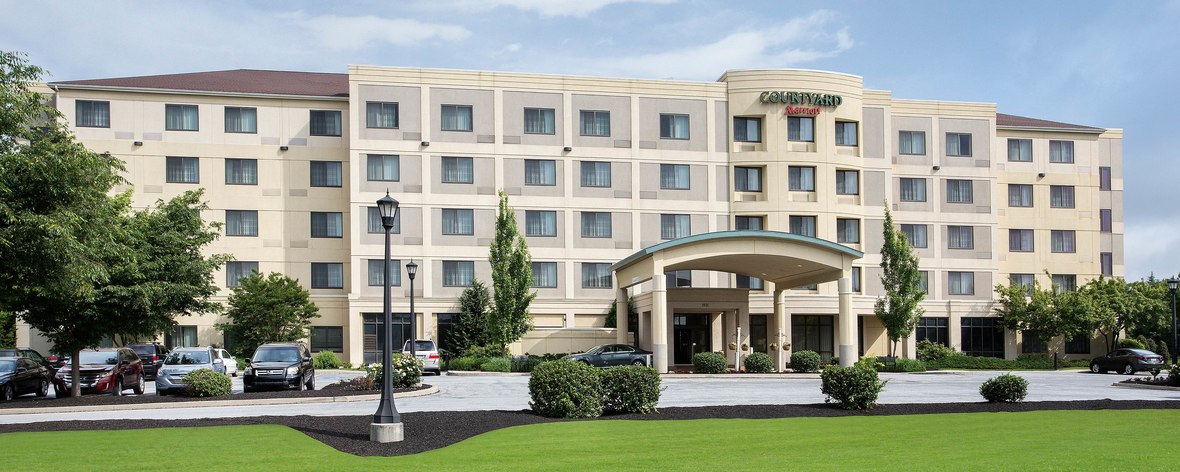A small, unassuming hotel in Lancaster, PA is making big news these days. It’s the first and only U.S. hotel at present to be fully powered by the sun. The Courtyard by Marriott Hotel recently completed a 135,200-square-foot solar installation that will be able to serve all the power needs of this 133-room hotel with efficiency and cost containment.
The progressive power grid was created by High Hotels, a family-owned development company in the Northeast U.S. that builds extended-stay properties franchised through Hilton Hotels Corporation and Marriott International. As the new construction supplies 100 percent of the Courtyard’s energy demands, such planning may mark the beginning of a trend in hospitality in an era that has hotel developers seeing what the impact of climate change will have on their businesses and fielding concerns from an ever-more planet conscious traveling population.
The Solar Energy Advantage
Hotels use up 50 percent more energy than a residential block of a comparable size, so hotel managers have to consider how to cope with rising energy costs. Going solar poses solutions for short and long-term sustainability.
Hotels and resorts often face complex considerations when going green. They differ from other commercial properties as they consume resources seven days a week and 24 hours a day. Lighting, HVAC and water heating account for approximately 60% of the total costs for a typical lodging facility. The U.S. Energy Star program estimates that hotels spent about $2,196 per room annually on energy alone.
There is no doubt that green-build planning and a focus on LEED certification is catching on in the U.S. In the hospitality industry, accounting for more thanfive billion square feet of developed space accounted in the United States alone, hotel properties stand to reap strong ROI for savings and conservation efforts.
* Upfront investment in green building makes properties more valuable, with an average expected increase in value of 4 percent. By virtue of lowered maintenance and energy costs, the return on investment from green building is rapid: a green retrofit project will generally pay for itself in just seven years.
* Green buildings reduce day-to-day costs year-over-year. LEED buildings, according to the U.S. Green Building Council, mean a nearly 20 percent dip in maintenance costs over typical commercial buildings, and green building retrofit projects typically decrease operation costs by almost 10 percent in just one year.
* Between 2015 and 2018, LEED-certified buildings in the United States created an estimated $1.2 billion in energy savings, $149.5 million in water savings, $715.2 million in maintenance savings and $54.2 million in waste savings.
* By 2021, in the U.S., green activity is expected to grow. Client demand remains the top trigger driving the market. Occupant health and well-being is the top social reason for building green.
Sustainability Demand in Hospitality
To complement these numbers, the hospitality industry is seeing another trend: a change in consumer behavior. Consumers are requesting sustainable resources, scrutinizing the indoor environment for pollution and waste and placing a preference on sustainable development when they have a choice.
Tax credits, such as the Obama-era U.S. solar Investment Tax Credit (ITC), has been extended through 2023. And, if the current administration does not attempt to reverse these credits, the kilowatt hours produced by the system can result in considerable energy savings. The Hampton Inn in Bakersfield, CA was able to use a 30% federal tax credit from ITC to build a 102kW solar system for its property. The program allowed the hotel to lower its energy bills by a third to a half and save an average of $7,400 to $8,800 per month.
At the Courtyard by Marriott in Lancaster, PA,hotel guests can see the solar power produced on a new real-time meter located in the lobby. Due to its size, more than twice as big as a football field, the 2,700-panel array was placed on the roof of a warehouse about half a mile from the hotel. Both the hotel and the warehouse are in Greenfield Corporate Center, a mixed-use business campus with a strong track record of sustainable practices, owned by High Properties.
The solar array produces 1,239,000 kWh of power for the hotel, which consumes 1,177,000 kWh. Excess power is sold to the local utility. High Hotels received a grant of $504,900 from the Commonwealth Financing Authority (CFA) through the Solar Energy Program to complete the project.
Supporting sustainable initiatives remains important to the lodging industry as a whole. As of 2018, 25 percent of domestic properties have received a Green Certification, the gold standard of sustainability. That number was up from 16 percent in 2016. Linen and towel reuse programs are nearly universal among properties, and most hotels across all segments have implemented a water savings program, according to a report released by the American Hotel & Lodging Association in March.
“Our guests now have the satisfaction of knowing that they are staying in a hotel that’s fully powered by the sun,” said Russ Urban, president of High Hotels. “We are strong believers in environmental stewardship and taking this step into renewables aligns with the interests of a growing segment of the traveling public.”
“We are excited to see High Hotels take the lead in such an impactful manner. The Courtyard Lancaster’s solar array installation is a concrete step forward to reduce our carbon footprint and minimize our impact on the environment,” said Denise Naguib, Vice President of Sustainability & Supplier Diversity for Marriott International. “Working in collaboration with our hotels, owners, guests and associates, we will Sustain Responsible Operations in order to meet the ambitious goals set as part of Marriott International’s sustainability and social impact platform, Serve360, and continue doing good in every direction.”
































































































































































































































































































Get Social